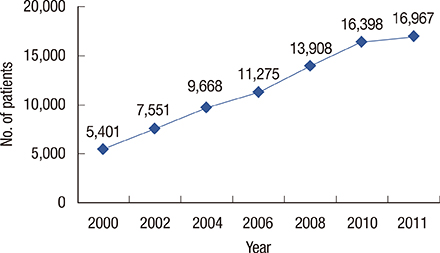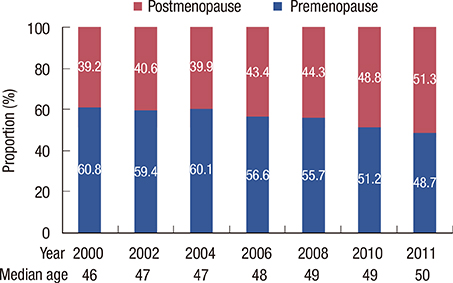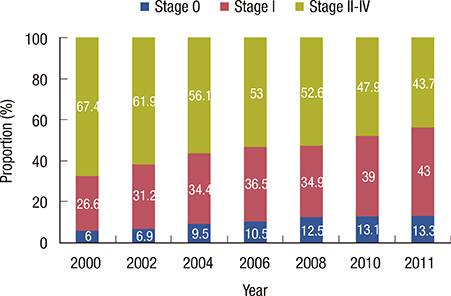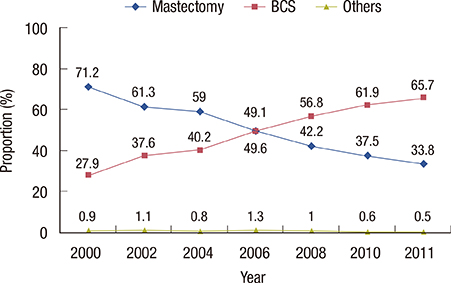J Breast Cancer.
2014 Jun;17(2):99-106.
The Basic Facts of Korean Breast Cancer in 2011: Results of a Nationwide Survey and Breast Cancer Registry Database
- Affiliations
-
- 1Department of Surgery, Soonchunhyang University Bucheon Hospital, Soonchunhyang University College of Medicine, Bucheon, Korea.
- 2Department of Surgery, Kyung Hee University Medical Center, Kyung Hee University School of Medicine, Seoul, Korea.
- 3Department of Surgery, Cheil General Hospital and Women's Healthcare Center, Kwandong University College of Medicine, Seoul, Korea. hmh1916@gmail.com
- 4Department of Social and Preventive Medicine, Inha University School of Medicine, Incheon, Korea.
- 5Department of Surgery, Inje University Haeundae Paik Hospital, Inje University College of Medicine, Busan, Korea.
- 6Department of Surgery, Chonbuk National University Medical School, Jeonju, Korea.
- 7Department of Surgery, Gachon University Gil Medical Center, Incheon, Korea.
- 8Department of Surgery, Seoul National University College of Medicine, Seoul, Korea.
Abstract
- Breast cancer is the second most frequent malignancy in Korean women, with a continuously increasing incidence. The Korean Breast Cancer Society has constructed a nationwide breast cancer database through an online registration program. The aim of the present study was to report the fundamental facts on Korean breast cancer in 2011, and to analyze the changing patterns in clinical characteristics and breast cancer management in Korea over the last 10 years. Data on newly diagnosed breast cancer patients, including the total number of cases, age, stage, and type of surgery, for the year 2011 were collected from 84 hospitals and clinics nationwide using a questionnaire survey. Additional data relating to the changing patterns of breast cancer in Korea were collected from the online breast cancer registry database and analyzed. According to nationwide survey data, a total of 16,967 patients were newly diagnosed with breast cancer in 2011. The crude incidence of female breast cancer, including invasive cancer and in situ cancer, was 67 cases per 100,000 women. Analysis of the survey and registry data gave equivalent results in terms of age distribution, stage, and type of surgery. The median age at diagnosis was 50 years, and the proportion of postmenopausal women (51.3%) was higher than that of premenopausal women (48.7%) with breast cancer. The incidence of stage 0 and stage I breast cancer increased continuously over the last 10 years (56.3% in 2011), and breast conserving surgery (65.7%) was performed more frequently than total mastectomy (33.8%). The total number of breast reconstruction surgeries increased approximately 8-fold. We conclude that the clinical characteristics of breast cancer have changed over the past 10 years in Korea, and surgical management has changed accordingly. Analysis of nationwide registry data will contribute to a better understanding of the characteristics of breast cancer in Korea.
Keyword
MeSH Terms
Figure
Reference
-
1. Jung KW, Won YJ, Kong HJ, Oh CM, Shin A, Lee JS. Survival of Korean adult cancer patients by stage at diagnosis, 2006-2010: national cancer registry study. Cancer Res Treat. 2013; 45:162–171.
Article2. Siegel R, Ma J, Zou Z, Jemal A. Cancer statistics, 2014. CA Cancer J Clin. 2014; 64:9–29.
Article3. Jung KW, Won YJ, Kong HJ, Oh CM, Seo HG, Lee JS. Cancer statistics in Korea: incidence, mortality, survival and prevalence in 2010. Cancer Res Treat. 2013; 45:1–14.
Article4. Cancer statistics. National Cancer Information Center, Ministry of Health and Welfare;Accessed May 3rd, 2014. http://www.cancer.go.kr.5. Korean Breast Cancer Society. Korean breast cancer data of 1996. J Korean Surg Soc. 1998; 55:621–635.6. Korean Breast Cancer Society. Korean breast cancer data of 1997. J Korean Cancer Assoc. 1999; 31:1202–1209.7. Ahn SH, Yoo KY. Korean Breast Cancer Society. Chronological changes of clinical characteristics in 31,115 new breast cancer patients among Koreans during 1996-2004. Breast Cancer Res Treat. 2006; 99:209–214.
Article8. Ko SS. Korean Breast Cancer Society. Chronological changing patterns of clinical characteristics of Korean breast cancer patients during 10 years (1996-2006) using nationwide breast cancer registration on-line program: biannual update. J Surg Oncol. 2008; 98:318–323.
Article9. Jung YS, Na KY, Kim KS, Ahn SH, Lee SJ, Park HK, et al. Nation-wide Korean breast cancer data from 2008 using the breast cancer registration program. J Breast Cancer. 2011; 14:229–236.
Article10. Ko BS, Noh WC, Kang SS, Park BW, Kang EY, Paik NS, et al. Changing patterns in the clinical characteristics of korean breast cancer from 1996-2010 using an online nationwide breast cancer database. J Breast Cancer. 2012; 15:393–400.
Article11. GLOBOCAN 2012 v1.0, Cancer incidence and mortality worldwide: IARC CancerBase No. 11. International Agency for Research on Cancer;Accessed May 4th, 2014. http://globocan.iarc.fr.12. Mousavi-Jarrrahi SH, Kasaeian A, Mansori K, Ranjbaran M, Khodadost M, Mosavi-Jarrahi A. Addressing the younger age at onset in breast cancer patients in Asia: an age-period-cohort analysis of fifty years of quality data from the international agency for research on cancer. ISRN Oncol. 2013; 2013:429862.
Article13. Ferlay J, Autier P, Boniol M, Heanue M, Colombet M, Boyle P. Estimates of the cancer incidence and mortality in Europe in 2006. Ann Oncol. 2007; 18:581–592.
Article14. Hirabayashi Y, Marugame T. Comparison of time trends in ovary cancer mortality (1990-2006) in the world, from the WHO Mortality Database. Jpn J Clin Oncol. 2009; 39:860–861.
Article15. Cho GJ, Park HT, Shin JH, Hur JY, Kim YT, Kim SH, et al. Age at menarche in a Korean population: secular trends and influencing factors. Eur J Pediatr. 2010; 169:89–94.
Article16. Gomez SL, Noone AM, Lichtensztajn DY, Scoppa S, Gibson JT, Liu L, et al. Cancer incidence trends among Asian American populations in the United States, 1990-2008. J Natl Cancer Inst. 2013; 105:1096–1110.
Article17. SEER cancer statistics review, 1975-2010. National Cancer Institute;Accessed April 22nd, 2014. http://seer.cancer.gov/csr/1975_2010/.18. Gøtzsche PC, Jørgensen KJ. Screening for breast cancer with mammography. Cochrane Database Syst Rev. 2013; 6:CD001877.
Article19. Independent UK Panel on Breast Cancer Screening. The benefits and harms of breast cancer screening: an independent review. Lancet. 2012; 380:1778–1786.20. Saji S, Hiraoka M, Tokuda Y, Fukui N, Ikeda T. Trends in local therapy application for early breast cancer patients in the Japanese Breast Cancer Society Breast Cancer Registry during 2004-2009. Breast Cancer. 2012; 19:1–3.
Article21. Mahmood U, Hanlon AL, Koshy M, Buras R, Chumsri S, Tkaczuk KH, et al. Increasing national mastectomy rates for the treatment of early stage breast cancer. Ann Surg Oncol. 2013; 20:1436–1443.
Article22. McLaughlin CC, Lillquist PP, Edge SB. Surveillance of prophylactic mastectomy: trends in use from 1995 through 2005. Cancer. 2009; 115:5404–5412.23. Tracy MS, Rosenberg SM, Dominici L, Partridge AH. Contralateral prophylactic mastectomy in women with breast cancer: trends, predictors, and areas for future research. Breast Cancer Res Treat. 2013; 140:447–452.
Article24. Jagsi R, Jiang J, Momoh AO, Alderman A, Giordano SH, Buchholz TA, et al. Trends and variation in use of breast reconstruction in patients with breast cancer undergoing mastectomy in the United States. J Clin Oncol. 2014; 32:919–926.
Article25. National Cancer Institute. Surveillance, Epidemiology, and End Results (SEER) Program SEER*Stat Database: Incidence - SEER 18 Regs Public Use, Nov 2012 Sub (2000-2010) - Linked to County Attributes - Total U.S., 1969-2011 Counties. Bethesda: National Cancer Institute, Division of Cancer Control and Population Sciences, Surveillance Research Program, Cancer Statistics Branch;2013.26. Kwong A, Mang OW, Wong CH, Chau WW, Law SC. Hong Kong Breast Cancer Research Group. Breast cancer in Hong Kong, Southern China: the first population-based analysis of epidemiological characteristics, stage-specific, cancer-specific, and disease-free survival in breast cancer patients: 1997-2001. Ann Surg Oncol. 2011; 18:3072–3078.
Article27. Sankaranarayanan R, Swaminathan R, Brenner H, Chen K, Chia KS, Chen JG, et al. Cancer survival in Africa, Asia, and Central America: a population-based study. Lancet Oncol. 2010; 11:165–173.
Article
- Full Text Links
- Actions
-
Cited
- CITED
-
- Close
- Share
- Similar articles
-
- The Basic Facts of Korean Breast Cancer in 2013: Results of a Nationwide Survey and Breast Cancer Registry Database
- The Basic Facts of Korean Breast Cancer in 2012: Results from a Nationwide Survey and Breast Cancer Registry Database
- Erratum: The Basic Facts of Korean Breast Cancer in 2011: Results of a Nationwide Survey and Breast Cancer Registry Database
- Basic Findings Regarding Breast Cancer in Korea in 2015: Data from a Breast Cancer Registry
- The Highligts of 28th Annual Meeting of San Antonio Breast Cancer Symposium






